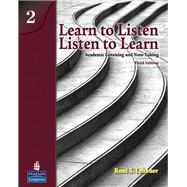
Note: Supplemental materials are not guaranteed with Rental or Used book purchases.
Purchase Benefits



What is included with this book?
UNIT 1 STARTING OUT: PRE-COURSEWORK EVALUATION
A. Evaluating Listening Comprehension and Note-Taking Skills
LECTURE 1: Academic Listening (Linguistics)
B. Teacher’s Note-Taking Feedback Form
C. Student's Goal-Setting Form
UNIT 2 THE STRUCTURE OF A LECTURE
A. Comparing the Language of Lecturing to the Language of Writing
B. Noticing Lecture Structure and Cues
C. Understanding the Role of Paraphrase, Repetition, Exemplification, and Digression
D. Key Differences between the Language of Lecturing and
the Language of Writing
E. Using Context and Prediction to Get Main Ideas
F. Predicting Content and Lecture Direction
UNIT 3 USING INTRODUCTIONS, CONCLUSIONS, AND DIGRESSIONS
A. Understanding Lecture Focus and Direction from Introductions
B. Using Conclusions to Check the Lecture's Main Points
C. Digressions
UNIT 4 NOTE-TAKING BASICS
A. Recognizing and Using Key Words
B. Making Abbreviations Work for You
C. Using Note-Taking Symbols and Abbreviations
D. Visually Representing Relationships and the Relative Importance
of Information
LECTURE 2: Women and Work (Sociology)
E. Note-Taking Practice
F. Eight DOs and DON’Ts for Improving Lecture Comprehension
and Note-Taking
UNIT 5 NOTING NUMBERS AND STATISTICS EFFECTIVELY
A. Numbers: A Review
LECTURE 3: Milestones in Technology (History/Technology)
LECTURE 4: Immigration to the United States (History/Sociology)
UNIT 6 LISTENING FOR ORGANIZATION (PART 1)
A. Understanding the Importance of Recognizing Lecture Organization
B. Recognizing Organizational Plans within Lectures
C. Defining Terms through Simple and Extended Definitions
D. Listing Subtopics
E. Exemplifying a Topic
LECTURE 5: Amnesty International (Political Science/Management)
LECTURE 6: Two 21st Century Eco-Heroes (Ecology)
UNIT 7 LISTENING FOR ORGANIZATION (PART 2)
A. Describing Characteristics
B. Describing a Process or Sequence of Events
C. Classifying Subtopics
LECTURE 7: Paging Robodoc: Robots in Medicine (Biology/Technology)
LECTURE 8: How to Look at Art (Art)
UNIT 8 LISTENING FOR ORGANIZATION (PART 3)
A. Describing a Causal Relationship
B. Comparing and Contrasting
C. Recognizing Generalizations and their Support
LECTURE 9: Hall’s Classification of Cultures (Sociology)
LECTURE 10 :Earthquakes: Can They Be Predicted? (Geology)
UNIT 9 TYING IT TOGETHER: END-OF-COURSE EVALUATION
LECTURE 11: Perfectionism (Psychology)
LECTURE 12: High-Tech Harvesting: Hope or Horror? (Agriculture/Ecology/Biology)
Appendix A Academic Word List Vocabulary
Appendix B Lecture Index by Organizational Plan
Appendix C Lecture Index by Subject Matter
Appendix D Rewritten Notes for Lectures
The New copy of this book will include any supplemental materials advertised. Please check the title of the book to determine if it should include any access cards, study guides, lab manuals, CDs, etc.
The Used, Rental and eBook copies of this book are not guaranteed to include any supplemental materials. Typically, only the book itself is included. This is true even if the title states it includes any access cards, study guides, lab manuals, CDs, etc.